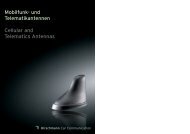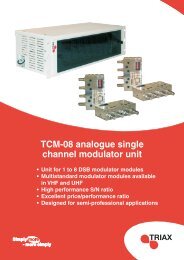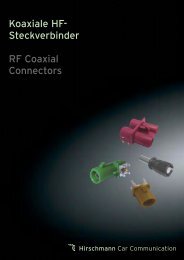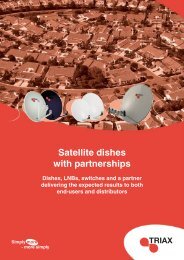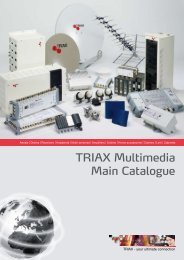Triax TD Unique.pdf
Triax TD Unique.pdf
Triax TD Unique.pdf
You also want an ePaper? Increase the reach of your titles
YUMPU automatically turns print PDFs into web optimized ePapers that Google loves.
TRIAX <strong>Unique</strong> Multi Reception Dish<br />
- a technical description<br />
Multi Satellite Reception<br />
With the increasing number of satellites follows the wish to receive signals<br />
from different (satellite) directions.<br />
There are several approaches to this, each with its own advantage and<br />
disadvantage.<br />
1) One dish for each satellite. Technically this is the best solution, as each<br />
dish can be optimized with respect to size and position. However to<br />
receive many satellites you need a lot of dishes!<br />
2) Sidemounting of LNB’s. Using this method an adjacent satellite can be<br />
received by offsetting an LNB from the true focus, thereby changing<br />
the beamdirection of the dish.<br />
However this “twisting” of the beam reduces gain - and the further<br />
away from the true focal point, the more gain is lost and so the available<br />
satellite signal. Offsetting two LNB’s symmetrically to each side of<br />
the focalpoint generally gives a better compromise, with less reduction<br />
of each signal.<br />
3) A motorized dish. With this solution one dish is covering all available<br />
satellites, however only one position can be received at a time and the<br />
installation and adjustment can be complicated.<br />
All three types of installations are used - depending on the individual<br />
requirement of the customers. And TRIAX offers the right products for<br />
each of these solutions.<br />
Fig. 1 Shows reduction in gain vs. change in azimuth beam angle on a<br />
<strong>TD</strong>78 dish with sidemounting.<br />
<strong>TD</strong> Dish 78 Reduction with offset-mounting of LNB<br />
Ref. val (dB): 37.00 - Scale/div. (dB): 1.00<br />
[dB ]<br />
0<br />
Advantage of TRIAX <strong>Unique</strong><br />
Multi Reception Dish<br />
The <strong>Unique</strong> Multi Reception Dish is the result of research into semi-parabolic<br />
shapes and the influence on available gain in both main and sidedirections.<br />
Through a special shaping we have streched the focal point into<br />
a focalline and still letting each LNB utilize all of the dish’s surface. Thus<br />
succesfully combining efficient area utilization of sidemounting with the<br />
broad and uniform azimuth beam coverage of the torus antenna.<br />
Fig. 3 TRIAX <strong>Unique</strong> Multi Reception Dish gain.<br />
<strong>TD</strong> <strong>Unique</strong> Multi Reception Dish<br />
Ref. val (dB): 37.00 - Scale/div. (dB): 1.00<br />
[dB ]<br />
0<br />
-1<br />
-2<br />
-3<br />
-4<br />
-5<br />
-30 -25 -20 -15 -10 -5 0 5 10 15 20 25 30<br />
[deg ]<br />
It is quite obvious, how the TRIAX <strong>Unique</strong> Multi Reception Dish design<br />
retains gain even at large changes of azimuth beam angles<br />
- where it really matters for multisatellite reception!<br />
-1<br />
-2<br />
-3<br />
Technical Specifications<br />
-4<br />
-5<br />
Type<br />
<strong>TD</strong> <strong>Unique</strong> Multi Reception Dish<br />
Part No.<br />
126390<br />
-30 -25 -20 -15 -10 -5 0 5 10 15 20 25 30<br />
[deg ]<br />
On a standard dish the LNB is placed in focus for best gain.<br />
A second LNB can be sidemounted for reception of an adjacent satellite.<br />
However gain is lost as this LNB is out of focus, and the losses increase<br />
dramatically with large offsets.<br />
For neighbouring satellites having 3 to 6 deg spacing this is uncritical -<br />
additional losses may be limited to 0,2 - 0,5 dB; however for separations<br />
of 10 deg or more, the losses quickly rise to 3 - 6 dB!<br />
Fig. 2 Comparison of gain distribution vs. azimuth beam angle using a<br />
standard <strong>TD</strong>78 dish and the TRIAX <strong>Unique</strong> Multi Reception Dish.<br />
Frequency range<br />
Gain (@ 11.7 GHz)<br />
X-polarisation<br />
Offset angle<br />
Reflector type<br />
Beam width<br />
10,7 - 12,75 GHz<br />
37.1 dBi<br />
> 20 dB<br />
26°<br />
Offset (F/D ratio 0.6)<br />
2.6°<br />
<strong>TD</strong>78 and <strong>TD</strong> <strong>Unique</strong> Multi Reception Dish Comparison<br />
Ref. val (dB): 37.00 - Scale/div. (dB): 1.00<br />
[dB ]<br />
Elevation range<br />
5 - 50 deg.<br />
0<br />
-1<br />
-2<br />
-3<br />
LNB adjustment<br />
(azimuth)<br />
Material<br />
+/- 17 deg.<br />
Pregalvanised steel<br />
-4<br />
-5<br />
-30 -25 -20 -15 -10 -5 0 5 10 15 20 25 30<br />
[deg ]<br />
There are certain antenna designs, where several LNB’s may be placed<br />
next to each other for multi satellite reception without change in individual<br />
performance. One such design is the torus dish, which has a rectangular<br />
reflector using a combination of a parabolic and circular shape.<br />
This design has the advantage that the focuses are placed on a line in<br />
front of the dish, where all LNB’s are placed. The disadvantage is, that<br />
each LNB only utilizes a minor part of the reflector, and as a consequence<br />
the gain is equivalent to that of a smaller dish.<br />
Finish<br />
LNB holder<br />
Size (w x h)<br />
Weight (kg)<br />
Windload (42m/s)<br />
Mast dimension<br />
Wall bracket<br />
Chromate, polyester powder coat<br />
Plastic feed holder<br />
Ø25/Ø40<br />
100 x 111 cm<br />
11<br />
950N<br />
Ø 28-Ø 63 mm<br />
- optional extra<br />
AB.17.4.02




